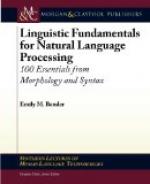“But,” says the objector, “you mistake. An intransitive verb is one where the ’effect is confined within the subject, and does not pass over to any object.’”
Very well, I think I understand the objection. When Thomas strikes David the effects of the blow passes over to him. And when he strikes himself, it “is confined within the subject,” and hence the latter is an intransitive verb.
“No, no; there is an object on which the action terminates, in that case, and so we must call it a transitive verb.”
Will you give me an example of an intransitive verb?
“I run, he walks, birds fly, it rains, the fire burns. No objects are expressed after these words, so the action is confined within themselves.”
I now get your meaning. When the object is expressed the verb is transitive, when it is not it is intransitive. This distinction is generally observed in teaching, however widely it may differ from the intention of the makers of grammars. And hence children acquire the habit of limiting their inquiries to what they see placed before them by others, and do not think for themselves. When the verb has an objective word after it expressed, they are taught to attach action to it; but tho the action may be even greater, if the object is not expressed, they consider the action as widely different in its character, and adopt the false philosophy that a cause can exist without an effect resulting from it.
We assume this ground, and we shall labor to maintain it, that every verb necessarily presupposes an agent or actor, an action, and an object acted upon, or affected by the action.
No action, as such, can be known to exist separate from the thing that acts. We can conceive no idea of action, only by keeping our minds fixed on the acting substance, marking its changes, movements, and tendencies. “The book moves.” In this case the eye rests on the book, and observes its positions and attitudes, alternating one way and the other. You can separate no action from the book, nor conceive any idea of it, as a separate entity. Let the book be taken away. Where now is the action? What can you think or say of it? There is the same space just now occupied by the book, but no action is perceivable.
The boy rolls his marble upon the floor. All his ideas of the action performed by it are derived from an observation of the marble. His eye follows it as it moves along the floor. He sees it in that acting condition. When he speaks of the action as a whole, he thinks where it started and where it stopped. It is of no importance, so far as the verb is concerned, whether the marble received an impulse from his hand, or whether the floor was sufficiently inclined to allow it to roll by its own inherent tendency. The action is, in this case, the obvious change of the marble.




